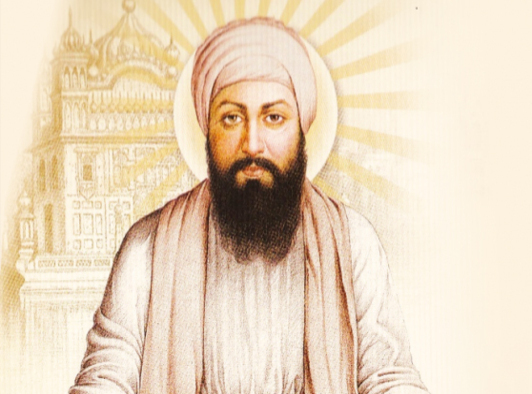The Guru Granth Sahib (or Adigranth) is the main scripture of the Sikh community. These were first renditioned, and compiled by Sri Guru Arjun Dev Ji, the fifth Guru of the Sikh community. The Prakash Utsav of Guru Granth Sahib was held on 30 August 1604 at Harimandir Sahib in Amritsar. In Damdama Sahib in 1705, Guru Govind Singh Ji’s father Shri Guru Teg Bahadur Ji completed it by adding 116 words of Guru Tegh Bahadur Ji, totaling 1430 pages.
The Guru Granth Sahib was composed predominantly by Six Sikh gurus: Guru Nanak, Guru Angad, Guru Amar Das, Guru Ram Das, Guru Arjan, Guru Teg Bahadur Ji. Sri Adigranth contains 5894 hymns, the largest number of 2216 hymns contribution is by Guru Arjan ji. Besides the hymns of other Gurus, he also included 937 hymns of 30 other saints and Muslim devotees from the different religions. While it speaks of Brahmin devotees like Jayadevji and Parmanandji, the representatives of castes considered hayas in the then Hindu society suffering from caste-based self-discrimination, such as Kabir, Ravidas, Namdev, Sain Ji, Saghna Ji, Chhivaji, Dhanna Speeches are also included.
The Sikh Gurus

Guru Nanak Dev Ji
(974 hymns)

Guru Angad Dev Ji
(62 Couplets)

Guru Amar Das Ji
(907 hymns)

Guru Ramdas Ji
(679 hymns)

Guru Arjan Dev Ji
(2,218 hymns)

Guru Tegh Bahadur Ji
(115 hymns)

Guru Gobind Singh Ji
(1 hymn)
The Shlok of Sheikh Farid, who believed in offering Namaz at all five times, are also in the Guru Granth Sahib. Guru Granth Sahib is unique in terms of its linguistic expression, philosophical, message. Their simplicity, comprehensibility, accuracy of language attracts the public. At the same time, the use of music notes and 31 ragas have also made the introspective esoteric spiritual teachings sweet and peacful.
The sacred verses of Sri Guru Granth Sahib Ji is called Gurbani, which means Guru Shabad or the narrative message enshrined in Sri Guru Granth Sahib Ji. In Sikhism, Guru is the word of wisdom, not a man or a book. God has revealed these words from time to time through pious men and women and the latest revelations are recorded in the text of Sri Guru Granth Sahib. For the Sikhs, no scripture contained in the Guru Granth is unacceptable because the Guru’s word or his theology has authority, and it is not allowed to be recited, sung, or discussed in Sikh congregations. With only the exception of Guru Gobind Singh Ji, Bhai Gurdas and Bhai Nand Lal Ji. These were considered to represent the Bani of the Guru Granth Sahib Ji. Those who interpret the Dharam Granth or teach the principles contained in the Adigranth are respected as teachers, granthi, missionaries, saints or enlightened souls in the Sikh religion.
On October 20, 1708, Guru Gobind Singh delivered his final sermon on the Damdama version of the Granth, a permanent Gurudom. He chose the town of Nader, several hundred miles from Damdama, for the ceremony. From that day on, this Granth is known as Sri Guru Granth Sahib.
From a linguistic point of view, the Guru Granth Sahib is a treasure trove of languages of its time, which communicate well with every section of society. The primarily applied language is the language of the saints, which developed during the Middle Ages. Based on local dialects, it was derived from Sanskrit, Prakrit, Persian, Arabic, Bengali and Marathi. Its appeal lies in its straightforwardness, energy and flexibility. In addition, the Guru designed a phonetically complete Gurmukhi font, which is also musical, to meet the need to interpret the multilingual scriptures.
The vision in Guru Granth Sahib is of a society which is based on divine justice without any oppression. Although the Granth discusses and respects the scriptures of Hinduism and Islam, it does not imply a moral harmony with any religion. It is housed in a Sikh shrine (Gurdwara). A Sikh usually bows or prostrates before entering such a temple. In Sikhism, the Granth is considered to be the eternal Gurbani and the spiritual authority in Sikhism.
